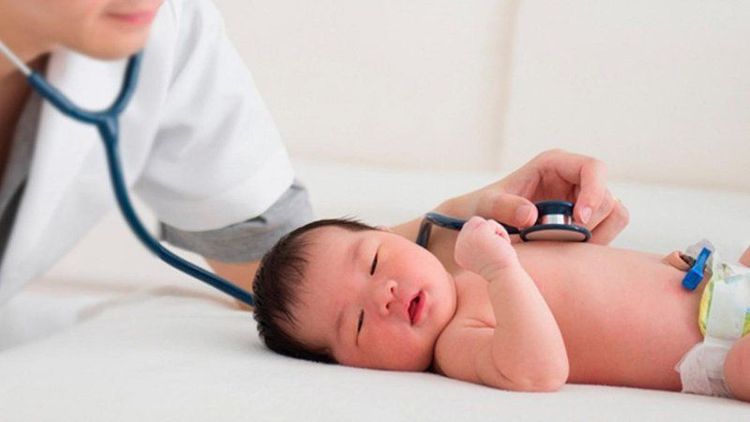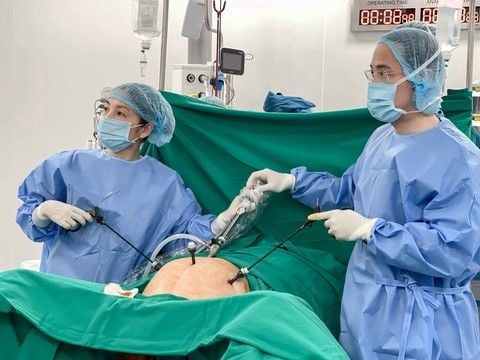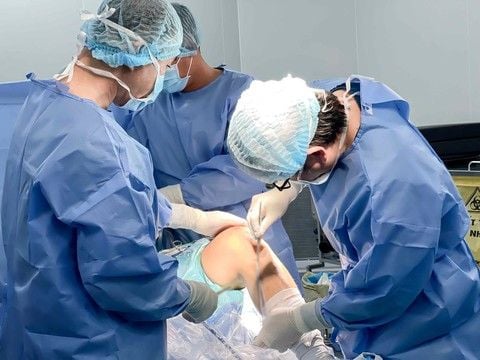This article is professionally consulted by Pediatricians - Neonatology Department - Vinmec Nha Trang International General Hospital.
Tuberculosis (TB) most commonly affects the lungs, but it can occur in any age group, from the elderly to young children. In newborns, TB can become severe. The best way to protect newborns from this disease is through BCG vaccination and a detailed understanding of TB for early diagnosis and treatment.
1. What is Tuberculosis?
Tuberculosis (TB) is an infectious disease caused by the bacterium Mycobacterium tuberculosis. It primarily affects the lungs, but it can also spread to other organs such as the spine, kidneys, and brain.
TB occurs in two stages:
- Stage 1: TB Infection (Latent TB): If a baby is infected with TB, a small number of TB bacteria are present in the body. However, the baby’s immune system keeps the bacteria from causing symptoms. People with latent TB do not spread the bacteria to others. Treatment is still needed to prevent the progression to active TB.
- Stage 2: Active Tuberculosis: If a baby develops active TB, the bacteria multiply, leading to severe symptoms. People with active TB can spread the disease, although newborns and young children rarely do.
2. Symptoms of Tuberculosis in Newborns
TB symptoms in newborns and young children may include:
- Persistent fever
- Loss of appetite
- Weight loss
- Weakness
- Night sweats
- Irritability
- Chronic cough
- Fast or labored breathing
These symptoms overlap with many other illnesses, so it is essential to take the baby to a doctor for an accurate diagnosis.
3. Causes of Tuberculosis in Newborns
- Inhaling TB Bacteria in the Air: Newborns can develop tuberculosis (TB) by inhaling airborne TB bacteria, which are released when an infected person coughs or sneezes. Children usually contract TB from adults, not from other children. This is because children’s mucus rarely contains high levels of bacteria, and their coughs are not strong enough to spread TB droplets into the air. Additionally, pediatric TB is generally less contagious than the adult form of the disease.
- Before or During Birth: A baby can contract TB while still in the womb or during childbirth if the mother is infected. The bacteria can pass through the placenta, or the newborn may become infected by swallowing infected vaginal fluids during delivery.
4. How Dangerous is Tuberculosis in Newborns?
Fortunately, most children infected with TB do not develop active disease. However, if TB progresses, it is especially dangerous for newborns and young children. Once TB bacteria enter a baby’s lungs, they begin to multiply. The bacteria can then spread through the bloodstream to the kidneys, spine, and brain. This dissemination (miliary TB) occurs more easily in newborns and children than in adults.

5. How Common is Tuberculosis in Children?
TB was once a leading cause of death in the United States. Between the mid-1980s and 1992, TB cases increased, reaching over 26,000 cases. However, the numbers have since declined, with only 9,000 cases reported in 2018, the lowest rate ever recorded. Of these, only 4% were children under 15 years old.
In contrast, tuberculosis remains a major health issue in parts of Asia and Africa. According to the World Health Organization (WHO), around 1 million children develop TB each year, with over 230,000 deaths. Across all age groups, approximately 10 million new TB cases were diagnosed in 2018.
6. Which Newborns Are at Risk for Tuberculosis?
Newborns are at the highest risk of developing tuberculosis (TB) if they:
- Live in a household where an adult has active TB.
- Are homeless, live in a shelter, or stay with someone who is incarcerated.
- Have a weakened immune system or an immune deficiency disorder such as HIV.
- Were born in a country with a high TB rate.
- Have traveled to a country where TB is widespread and had prolonged exposure to people there.
- Live in communities with poor healthcare services.
7. What Should Parents Do If They Suspect Their Baby Has Been Exposed to Tuberculosis?
The first thing parents should do is consult a doctor immediately if their baby has been exposed to someone with tuberculosis or if they suspect their baby has TB symptoms. Newborns and young children have a higher risk of complications, such as TB meningitis. Early diagnosis and treatment are crucial to prevent severe illness.
8. How Is Tuberculosis Diagnosed in Newborns?
If a doctor suspects TB in a newborn, they may perform the following tests:
- Tuberculin Skin Test (TST): A small amount of TB protein extract is injected into the baby’s forearm. The injection site is examined 48–72 hours later for a reaction. If a raised bump appears, the doctor will measure its size and hardness to determine if the test is positive. In some cases, a blood test is used instead, though this is more common for children over 5 years old.
- Repeat Testing If Needed. It can take 2 to 12 weeks after TB exposure for a test to turn positive. If the initial test is negative, the doctor may repeat it about three months later.
- Chest X-ray. If a skin or blood test is positive, a chest X-ray is needed. A positive test result means the baby has been infected but may not have active TB disease. The X-ray helps determine whether active TB is present.
- Testing Sputum or Stomach fluids. If an X-ray suggests infection, the doctor may collect samples of the baby’s mucus (sputum) or stomach fluid. This helps confirm TB bacteria presence and determine the appropriate treatment.
9. Treatment of Tuberculosis in Newborns
The treatment of tuberculosis in newborns depends on the stage of the disease, including:
- Latent TB Infection: If the baby is infected but has not developed the disease, they will need to take antibiotics daily for three to nine months to prevent TB from progressing.
- Active Tuberculosis: If the baby has TB disease, they may need to take three or four medications for at least six months, depending on the severity of the illness. (Doctors recommend multiple medications at once to prevent drug resistance.) The baby will also require regular medical check-ups to monitor treatment progress and manage any potential side effects.
Although the baby may feel better and show signs of improvement after a few weeks of medication, it is crucial to complete the entire treatment course. Otherwise, the disease may return in a more drug-resistant form.

10. Methods to Prevent Tuberculosis in Newborns
Living in the United States means a low risk of tuberculosis for children. However, the risk of infection can be further reduced by:
- Avoiding contact with people who have TB, especially when traveling abroad.
- Maintaining a good standard of living.
- Washing hands regularly.
- Sneezing and coughing into a tissue or elbow, not hands.
- Not sharing towels, eating utensils, or drinking cups.
Should Infants Receive the TB Vaccine?
The tuberculosis vaccine (BCG) is not routinely given in the U.S. because:
- Its effectiveness is uncertain.
- TB incidence is low in the U.S.
- The vaccine may interfere with TB skin test results. (A vaccinated baby may have a false-positive TB skin test.)
However, in countries where TB is common, newborns routinely receive the BCG vaccine as part of their national immunization programs.
In Vietnam, the BCG vaccine is mandatory and is part of the National Immunization Program. TB prevention is crucial—not only for individual health but also for community protection.
Vinmec International General Hospital offers vaccination services with a variety of vaccines to meet different patient needs:
- Comprehensive health screening by specialists before vaccination. Expert consultation on vaccine selection, schedules, and post-vaccination care based on the latest recommendations from the Vietnam Ministry of Health & WHO.
- Experienced medical staff who provide professional and pain-reducing techniques during vaccination.
- 100% of customers will be monitored for 30 minutes post-vaccination to ensure patient safety before discharge.
- Comprehensive medical monitoring is provided before, during, and after vaccination at Vinmec, with an emergency team always ready to coordinate with the vaccination unit to manage cases of anaphylaxis, respiratory failure, and cardiac arrest, ensuring timely and protocol-compliant intervention in case of any complications.
- Comfortable vaccination rooms with play areas to keep children relaxed before and after vaccination.
- Vaccines imported and stored under GSP-standard cold chain systems to ensure quality.
- Automated appointment reminders and synchronized immunization records with the National Immunization Information System.
Reference source: babycenter.com
To arrange an appointment, please call HOTLINE or make your reservation directly HERE. You may also download the MyVinmec app to schedule appointments faster and manage your reservations more conveniently.


